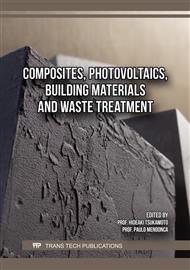[1]
Hongyu Zheng and Kui Liu (2013) Machinability of Engineering Materials. Handbook of Manufacturing Engineering and Technology. Springer-Verlag London
DOI: 10.1007/978-1-4471-4976-7_2-1
Google Scholar
[2]
Jay Zeng (2007) Determination of Machinability and Abrasive Cutting Properties in AWJ Cutting. 2007 American WJTA Conference and Expo. Houston, Texas
Google Scholar
[3]
Vijay Kumar Pal and Puneet Tandon (2013) Identification of the Role of Machinability and Milling depth on Machining Time in Controlled Depth Milling using Abrasive Water Jet. International J Advanced Manufacturing Technology 66:877–881
DOI: 10.1007/s00170-012-4373-z
Google Scholar
[4]
Lisa Dekster, Nikolaos Nikolaos Panagiotis Karmiris-Obratanski and Angelos P. Markopoulos (2023) Evaluation of the Machinability of Ti-6Al-4V Titanium Alloy by AWJM Using a Multipass Strategy. Applied Science, 13, 3774. doi.org/
DOI: 10.3390/app13063774
Google Scholar
[5]
A. Perumal, C. Kailasanathan , Vincent Herald Wilson, T. Sampath Kumar, B. Stalin, P.R. Rajkumar (2021). Machinability of Titanium alloy 6242 by AWJM through Taguchi method. Materials Today: Proceedings, Volume 81, Part 2, 2023, Pages 606-611
DOI: 10.1016/j.matpr.2021.04.067
Google Scholar
[6]
Mingchao Du, Kun Zhang, Yanli Liu, Long Feng, Chunyong Fan (2022) Experimental and Simulation Study on the Influence Factors of Abrasive Water Jet Machining Ductile Materials. Energy Reports, Volume 8, November 2022, Pages 11840-11857. doi.org/
DOI: 10.1016/j.egyr.2022.09.035
Google Scholar
[7]
Ashwin Polishetty and Guy Littlefair (2020) Comparative Study of Machinability of Additive Manufactured and Wrought Titanium Alloy using Abrasive Waterjet Machining. Proceedings of the Canadian Society for Mechanical Engineering International Congress, CSME Congress, Charlottetown, PE, Canada, 5P
DOI: 10.32393/csme.2020.1267
Google Scholar
[8]
S.B. Supriya and Satyanarayana Srinivas (2018). Machinability Studies on Stainless Steel by Abrasive Water Jet -Review. Materials Today: Proceedings, 5(1), 2871–2876
DOI: 10.1016/j.matpr.2018.01.079
Google Scholar
[9]
Wasif Mukaddam; Arjun Ramchandran; Manivannan Sugavaneswaran (2021) Study of Effect on Machinability by Hybrid Abrasive Materials in AWJM. Materials, Mechanics & amp; Modelling (NCMMM-2020) AIP Conference Proceedings. 2341, 040006
DOI: 10.1063/5.0050218
Google Scholar
[10]
M. Adam Khan and Gupta Kapil (2020). Machinability Studies on Abrasive Water Jet Machining of Low Alloy Steel for Different Thickness. IOP Conference Series: Materials Science and Engineering, 709, 044099–
DOI: 10.1088/1757-899x/709/4/044099
Google Scholar
[11]
H. Thakkar Kamlesh, M. Prajapati Vipul and A. Thakkar Shreyash (2013) A Machinability Study of Mild Steel using Abrasive Water Jet Machining Technology, International Journal of Engineering Research and Applications (IJERA) ISSN: 2248-9622 www.ijera.com Vol. 3, Issue 3, pp.1063-1063
Google Scholar
[12]
V. E. Beal; P. Erasenthiran; N. Hopkinson; P. Dickens, and C. H. Ahrens (2006) Optimisation of Processing Parameters in Laser Fused H13/Cu Materials using Response Surface Method (RSM). Journal of Materials Processing Technology, 174, 145–154.
DOI: 10.1016/j.jmatprotec.2005.04.101
Google Scholar
[13]
M. Uthayakumar, M. Adam Khan, S. Thirumalai Kumaran, Adam Slota & Jerzy Zajac (2015). Machinability of Nickel-Based Superalloy by Abrasive Water Jet Machining. Materials and Manufacturing Processes, 10426914.2015.1103859–.
DOI: 10.1080/10426914.2015.1103859
Google Scholar
[14]
C. Joel and Thangasamy Jeyapoovan (2021) Optimization of Machinability Parameters in Abrasive Water Jet Machining of AA7075 using Grey-Taguchi method. Materials Today Proceedings, Volume 37, Part 2, 2021, Pages 737-741
DOI: 10.1016/j.matpr.2020.05.741
Google Scholar
[15]
R. Shibin, V. Anandakrishnan, S. Sathish, Vinod Mallemala Sujana (2019). Investigation on the Abrasive Water Jet Machinability of AA2014 using SiC as Abrasive. Materialstoday: Proceedings, (), S2214785319320322–
DOI: 10.1016/j.matpr.2019.06.659
Google Scholar
[16]
Salem A Basher Ibrahim; Korkmaz Seyma; Muhammet Hüseyin Çetin; Fuat Kartal (2020). Performance Evaluation of the Submerged Abrasive Water Jet Turning Process for Improving Machinability of Castamide. Engineering Science and Technology, an International Journal, Volume 23, Issue 4, Pages 801-811
DOI: 10.1016/j.jestch.2020.06.009
Google Scholar
[17]
S. Muralidharan; I. Aatthisugan; A. Tripathi; H. Baradiya; A. Singh (2018). A Study on Machinability of Polymer Composite by Abrasive Water Jet Machining. IOP Conference Series: Materials Science and Engineering, 402(), 012102–
DOI: 10.1088/1757-899X/402/1/012102
Google Scholar
[18]
Mohamed El-Hofy; Mohamed Osama Helmy; Gustavo A Escobar-Palafox; Kevin Kerrigan; R. Scaife; and Hassan A El-Hofy (2018) Abrasive Water Jet Machining of Multidirectional CFRP Laminates. Procedia CIRP, 68, 535–540
DOI: 10.1016/j.procir.2017.12.109
Google Scholar
[19]
HA Youssef, HA El-Hofy, AM Abdelaziz, and MH El-Hofy (2020) Accuracy and Surface Quality of Abrasive Waterjet Machined CFRP Composites. Journal of Composite Materials, Vol. 55, Issue 12, Pages 1693-1703. doi.org/
DOI: 10.1177/0021998320974428
Google Scholar
[20]
N. R. Prabhuswamy, Satyanarayana Srinivas, Aref Vasli, M. V. Sheshashayan, S. Venkatesh, Yash Roongta (2018). Machinability studies of aluminium 6061 cut by abrasive water jet. Materials Today: Proceedings, 5(1), 2865-2870.
DOI: 10.1016/j.matpr.2018.01.078
Google Scholar
[21]
Panagiotis Karmiris-Obratański; Nikolaos E Karkalos; Rafał Kudelski; Emmanouil L Papazoglou; Angelos P Markopoulos (2021). On the Effect of Multiple Passes on Kerf Characteristics and Efficiency of Abrasive Waterjet Cutting. Metals. 11(1), 74
DOI: 10.3390/met11010074
Google Scholar
[22]
Srecko Ćurčic, Jelina Baralić, , Sandra Milunovic, Milan Pavlovic, Slavko Arsoviski, and Ljubinka Radosavljevic (2011) Techno-economic Analysis of Abrasive Water-Jet Machining and Wire Electrical-Discharge Machining. Strojarstvo, 53 (4) 249-258. ISSN 0562-1887.
Google Scholar


